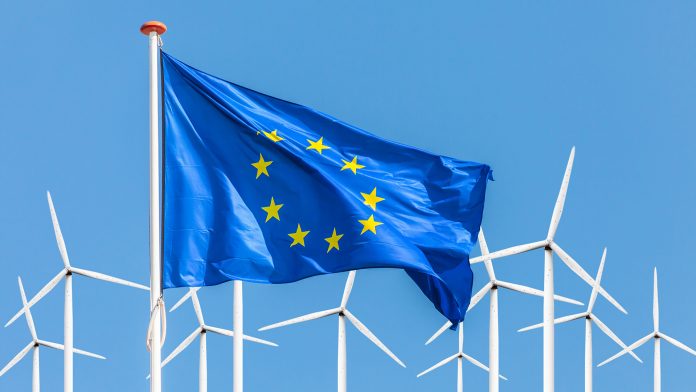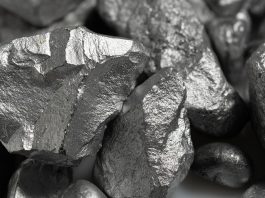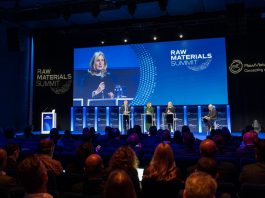Dr Evi Petavratzi and Eimear Deady from the British Geological Survey discuss the Critical Raw Materials Act and Europe’s future supply chains for critical raw materials.
As the energy transition ramps up and demand for metals used to power batteries accelerates, the need for critical minerals and metals is more pressing than ever. In particular, critical raw materials (CRMs) are of key concern due to their growing economic importance and high risk of supply shortage.
The European Commission (EC) defines 34 materials as critical, including antimony, arsenic, bauxite, baryte, beryllium, bismuth, boron, cobalt, coking coal, copper, feldspar, fluorspar, gallium, germanium, hafnium, helium, heavy rare earth elements, light rare earth elements, lithium, magnesium, manganese, natural graphite, battery-grade nickel, niobium, phosphate rock, phosphorus, platinum group metals, scandium, silicon metal, strontium, tantalum, titanium metal, tungsten, and vanadium.
Traditionally, Europe has been almost wholly dependent on imports of critical raw materials from other counties around the world. To resolve this issue and secure the European Union’s (EU) future supply of critical raw materials, the EC passed the Critical Raw Materials Act in March 2023. The Act proposes a set of actions to ensure the EU’s access to a secure, diversified, affordable and sustainable supply of critical raw materials.
The British Geological Survey (BGS) conducts extensive research into critical raw materials and vulnerability to supply disruption by monitoring global mineral production and trade, mapping supply chains, and analysing markets. The organisation works closely with government, academia, and industry to deliver integrated research for critical raw materials across the entire value system.
Its sustained activity in this area has greatly raised the profile of critical raw material security-of-supply issues. It has influenced the research agenda for this topic in the UK and Europe.
One particular project that the BGS collaborates on, alongside the Universities of Exeter, Birmingham, Leicester, and Manchester, is Met4Tech. Focused on strengthening the UK supply chain for essential metals for modern technology, the Met4Tech Circular Economy Centre brings together UK research teams already working on how to improve and assure the supply of raw materials, how to design for reuse, refurbishment and remanufacture, and how to recycle complex goods such as batteries. The Centre is conducting new interdisciplinary research on key interventions to improve each stage in the cycle and join the different stages of the value chain together such that critical raw materials can be recovered and recycled, and product manufacture can become more circular.
The British Geological Survey’s Principal Mineral Commodity Specialist Dr Evi Petavratzi, and Senior Economic Geologist Eimear Deady, are heavily involved in the Met4Tech project and with BGS’ overall research on UK and European critical raw materials supply chains. Editor Georgie Purcell spoke with them both to gain their perspective on Europe’s critical raw material potential and learn more about the Met4Tech project.
How would you describe the overall outlook for Europe’s current critical metals and minerals supply chains?
Eimear Deady (ED): While Europe has predominantly relied on imports, there is some mining in the region, and some countries’ jurisdictions have considerably more mining and are more advanced in their processing and refining. For instance, Nordic countries, such as Finland, have a better developed supply chain for certain metals. Overall, however, Europe has been very dependent on material imports. This is slowly changing, as policymakers understand that relying on external imports of raw materials is not wholly reliable and are therefore implementing strategies to address this – the Critical Raw Materials Act, for example.
Evi Petavratzi (EP): The supply of critical raw materials to Europe is quite problematic. Rare earth elements (REE) have very tight supply chains, dominated mainly by China and Myanmar, which could make it difficult for Europe to intercept. Equally, the list of critical minerals is expanding with each assessment. Yet, after a decade of assessments and analysis, we have not seen any of these critical materials being removed from that list. This, therefore, raises the question of whether we are taking the right actions.
As it tries to improve the critical minerals governance framework, Europe’s biggest challenge is time. The window of opportunity for many of these minerals is small, especially those integral to decarbonisation and digital technologies. Moreover, the dynamic landscape of new applications is progressing much faster than Europe’s progress in establishing domestic supplies of resources.
ED: In the context of CRMs, it is hard to determine what the EU demand is, for example on material forms. Given that most processing happens elsewhere, deciding if demand relates to the raw materials or the actual component, or product, is hard to quantify. Similarly, it is difficult to properly identify the needs of each country or region, whether that be manufacturing requirements or demand metabolism.
Supply chains can also be convoluted. For example, Belgium and Finland – two countries with refining capacity in Europe – import unrefined metals, which are processed and then re-exported. In addition, cobalt produced from the Democratic Republic of the Congo (DRC), is partly processed in China, and is further refined in Finland before being sold and re-exported. Of course, this generates a considerable carbon footprint that has seldom been addressed in research on supply chains.
EP: Decarbonisation is happening globally, and nations are competing to secure the technologies and materials they need to build greener technologies. Within the European Union (EU), countries have set their targets and objectives related to renewable technologies and the reduction of CO2 emissions. This then generates competition both within Europe and the rest of the world. It also causes challenges around supply chain co-ordination.
How will the EU’s Critical Raw Materials Act impact supply chains?
EP: The EU Critical Raw Materials Act is important because previously we relied on national legislation and there was no EU-level governance. The EU has set up specific rules for securing critical raw materials and improving supply chains, alongside targets related to European exploration and processing. The big question is whether we will achieve these targets and what the implementation of the EU’s vision will look like, mainly because there have been limited new mine production projects in the last decade.

The EU Critical Raw Materials Act was introduced in March 2023
ED: The Act states no more than 65% of the EU’s annual consumption of each strategic raw material at any relevant stage of processing can come from a single third country. However, that is near impossible for many of the CRMs. In Brazil, for example, one mine produces nearly all the world’s niobium. While a few mines produce rare earths, almost all the processing goes through China and Malaysia.
The EU may be able to reach its benchmarks for domestic capability for recycling (15%) and the processing target of 40%. However, the target of no more than 65% consumption of CRMs from a single third country is going to be very challenging to achieve. There is some ambiguity around the targets set up in the CRM Act. For example, it is unclear what the 2030 10% target of domestic strategic raw material demand from EU’s capacity actually refers to.
EP: Whether these targets apply to individual commodities and in what form is unclear.
There are many questions about what these numbers mean, and we await more clarification.
Even if advanced exploration projects are happening in Europe, such as we have seen for lithium, you need to secure significant funds to ensure, first and foremost, that your project will be successful. But at the same time, you must be able to navigate legislative challenges, regulatory frameworks related to minerals, and all the permitting and licencing requirements for advanced projects to go into production in six and half years. Usually, this process takes two decades.
ED: One of the things the EU does not overtly talk about is environmental, social and governance (ESG). It states it will take measures but has yet to address the impact on people or the planet.
How can these challenges be addressed, and what needs to change?
ED: The social license to operate is listed as the number one risk to every project. The overall global acceptance of mining has decreased. Outreach is one of the most significant ways to address social and planetary concerns and ensure people understand the requirements for new technologies. A mobile phone, for example, requires critical raw materials to make. We can recycle some of those, but we cannot recycle our way out of increased demand. So, we will need new mines.
Another critical challenge is the command China holds over processing. We have lots of very interesting rocks in Europe, from which you could obtain metals. Still, that processing bottleneck sits in China primarily because we have yet to develop that capacity anywhere else in the Western world. It is not the case for everything – copper, lead, zinc, cobalt and nickel some refining capacity exists in Europe but certainly not enough to satisfy our needs, and for key minerals like lithium and graphite the processing capacity is very limited. Processing challenges could be addressed by investing into building new plants in Europe, but the energy costs, water costs, and environmental regulations are more stringent here. As a result, consumers would need to pay more for their products because they are produced in these countries with higher wages, higher welfare, and environmental protections.
EP: Regarding availability, we analysed European cobalt deposits and identified about 500 different cobalt occurrences in Europe that could potentially lead to some development. But issues across environmental, social and governance (ESG) implications mean that we are likely to find it difficult to develop these into producing projects.
The social license to operate is a huge consideration. Many land use issues exist. For instance, if you look at Scandinavia, which is one of our major mining areas in Europe, a significant problem is land use because of deposits residing within protected zones, reindeer herding areas and Indigenous communities. Many of them are close to the Arctic Circle, which has major climate change implications. People in Europe are aware of these aspects; however, attitudes in southern parts of Europe are very different. In the south, communities are more likely to be averse to outsiders coming in and using the land’s resources. Historically, there have been cases where resources have been exploited, developers have abandoned projects when they ceased to be economic, and communities were left to deal with the environmental impacts that developed due to mining. More so today, good practice mineral governance should encourage social participation and for communities to be a part of decisions and discuss how these projects might influence their future.
China has been very proactive in securing critical raw materials and has a long-term industrial strategy. They have investigated critical raw materials globally, trying to see whether they can secure supply outside China, not just within it. Nobody else has been doing it, so this needs a lot of resource diplomacy, which we have been doing, but we need to intensify it.
Not only do we need more processing capacity but skilled people. We have lost a lot of skilled people in mining in Europe, and we must rebuild that.
How is the Met4Tech project helping to strengthen critical metals supply chains? What are the latest takeaways from the project?
EP: Met4Tech looks at the circular economy for technology metals and improving understanding of global supply chains. Our focus is primarily on specific applications, including batteries, magnets in wind turbines and electric vehicles. One of the key things we can provide is much better clarity on complex systems, supply chains, and data, which is significant.
Regarding the circular economy, we want to understand the stocks and flows of rare earths in the UK economy for the signature applications mentioned earlier. As a consuming country with aggressive renewable energy targets, we are building a stock in the anthropogenic environment. We want to know how this stock will grow over the years, and understand the potential for the UK to build up a circular economy ecosystem to recover some of the critical minerals that could not be mined domestically.
We have focused primarily on rare earths and how that value chain integrates globally. We are using scenario analysis to understand how much of our rare earths, particularly those needed for green technologies, can come from secondary supply. We are planning to repeat a similar approach for lithium-ion batteries. In addition, we are developing a UK technology metals observatory where information will be available to the public.
ED: My role in Met4Tech has been to look at the wider global supply chain of rare earths, and one of its interesting parts is Myanmar’s growing role in that supply chain. Historically, China produced a lot of rare earths from a deposit type called ion-adsorption deposits, which has a significant environmental impact because of the chemicals used. The Chinese Government has been implementing measures to improve this. Because of Myanmar’s unregulated system and current status politically, an opportunity has been taken to do the same type of mining or extraction in the northeastern part of Myanmar, just along the border with China. As such, I have been looking at trade data and the supply flow of rare earths from Myanmar. The volume and value of these flows have increased enormously in the last five years. We hope to publish findings on remote sensing data showing the change in land use over the last four or five years soon.
EP: The work we have been doing represents just one area of the project, but Met4Tech is also looking at recycling technologies and is also developing a roadmap around technology metals coming from the circular economy.
Please note, this article will also appear in the fourteenth edition of our quarterly publication.









